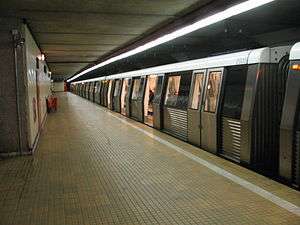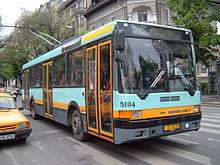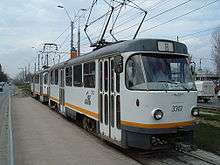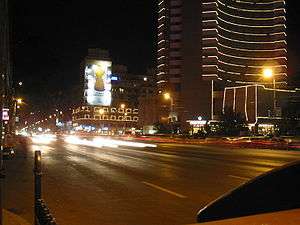Transport in Bucharest
Bucharest has the largest transport network in Romania, and one of the largest in Europe. The Bucharest transport network is made up of a metro network and a surface transport network. Although there are multiple connection points, the two systems operate independently of each other, are run by different organisations (the metro is run by Metrorex and the surface transport network by RATB) and use separate ticketing systems.

Bucharest Metro
Bucharest has a fairly extensive metro system consisting of four lines (M1, M2, M3 and M4) run by Metrorex. In total, the network is 69.25 km (43.0 mi) long and has 51 stations,[1] with 1.5 km (0.9 mi) average distance between stops. It is one of the fastest ways to get around the city.

Surface transport
Surface transport in Bucharest is run by Regia Autonomă de Transport Bucureşti (RATB) and consists of an extensive network of buses, trolleybuses, trams and light rail. The RATB network is one of the most dense in Europe, and the fourth largest on the continent, carrying about 1.7 million passengers daily on 85 bus lines, 23 tram lines, 1 light rail line and 15 trolleybus lines. At times, however, it does suffer from severe overcrowding.
RATB is a reasonably efficient and a very frequently-used way of getting around Bucharest. As with the Metro, the system is going under a period of renewal. Some new features are the upgrade of tram/trolleybus infrastructure and the replacement of old rolling stock.
Buses
| Wikimedia Commons has media related to Buses in Bucharest. |
With a total route length of 1,374 km (854 mi),[2] the RATB bus network is the most dense out of all the transport types in Bucharest. There are 85 bus lines (plus 25 night routes), most of which operate in the Municipality of Bucharest. However, there are also 11 bus lines which provide services to the towns and villages which border Bucharest, in Ilfov county, and whose populations usually commute to Bucharest for work. In mid-2005, the lines that linked the city to the peripheral area were licensed out to independent transportation providers, but in early 2006, they were placed once again under the control of RATB due to a wide range customer complaints about the private operators.
Fleet
RATB's bus fleet is made up of 1014 vehicles (in 2012), of which around 99% are wheelchair-accessible (low floor) and around 55% are air-conditioned.[3]
Between 2005 and 2009, the fleet underwent its most substantial process of renewal since 1989, and is now among the most modern in Europe. In December 2005, RATB signed a contract for 500 Mercedes Citaro low-floor, wheelchair-accessible buses. The buses were delivered between June 2006 and April 2007. In January 2008, the first of a further series of 500 Citaro low-floor buses were put into service.
The fleet makeup, as of 2015, is as following:
Low floor Mercedes Citaro buses are the main type of bus used in Bucharest(about 99%), running on almost all the routes. The prototype models, such as HESS, DAF Berkhof and Rocar Autodromo aren't used anymore. Older models were retired completely from circulation (Rocar de Simon U412), but there are a few buses DAF SB220 used for regional/rural routes in Ilfov County (preorășenești).
Trolleybuses
| Wikimedia Commons has media related to Trolleybuses in Bucharest. |
Trolleybuses supplement buses on the RATB system network, which operates 15 trolleybus lines (mainly on high-usage routes), measuring 164.1 km (102.0 mi) of routes[2] on 73.2 km (45.5 mi) network.[4] During the 1990s, the fleet was updated with modern trolleybuses manufactured by Ikarus, in light blue and yellow livery, which have acoustic station announcements and digital display screens. These trolleybuses now make up the majority of the fleet. In early 2007, 100 wheelchair-accessible Irisbus Citelis trolleybuses were introduced on routes 61, 62, 69, 70, 86, 90, 91 and 92. Two distinct, non-interconnected networks exist in Bucharest, the main network (comprising the two main East-West lines as well as a spur in the Northern part of town) and a relatively small Southern network in Berceni. Each of the two networks have their own, separate trolleybus depots (including separate fleets) and are not connected in any way. The trolleybus network is currently being overhauled or expanded - a goal is to eventually unite the two networks.
Fleet

 Irisbus Citelis
Irisbus Citelis
trolleybus on Route 91
100 vehicles Ikarus 415T
Ikarus 415T
trolleybus on Route 70
200 vehicles
Trams and light rail
| Wikimedia Commons has media related to Trams in Bucharest. |
RATB operates a complex system of trams measuring 332.2 km (206.4 mi) of routes[2] on 145 km (90 mi) tram network throughout Bucharest.[4] Beside 23 tram lines, there is currently one converted light rail line (so called metrou uşor which translates as light metro), numbered 41, which runs in the western part of Bucharest. Line 41 uses upgraded trams and also runs on separate designated corridors for faster travel times. Most of the tram infrastructure in Bucharest has either been overhauled or completely upgraded in the last 5 years, or is currently being overhauled. The light rail service is expected to be expanded by upgrading existing tram lines to light rail status.
Most trams operated by RATB (all V3A, Bucur 1 and Bucur LF models) are manufactured internally by RATB at their subsidiary URAC Bucharest (the same subsidiary also handles tramway repairs and is in charge with scrapping vehicles reaching the end of their useful service life). Currently, URAC produces three models for RATB - two three-section, partially low-floor, wheelchair-accessible models (V3A-CH-PPC derived from the earlier V3A-93 model and the all-new Bucur-LF model) as well as a two-section, non-wheelchair-accessible model (Bucur 1), derived from the older Tatra trams.
Routes 1, 32 and 41 are wheelchair-accessible, using new V3A-CH-PPC and Bucur LF trams. Other routes will become wheelchair-accessible as soon as more V3A-CH-PPC or Bucur-LF vehicles are constructed (URAC's building capacity is limited).
The maximum speed of the trams within Bucharest lies at 60 km/h
Fleet

 Bucur LF low-floor tram
Bucur LF low-floor tram
 V3A-CH-PPC low-floor tram
V3A-CH-PPC low-floor tram Bucur-1 tram
Bucur-1 tram Bucur-1-V2S tram
Bucur-1-V2S tram
Only 2 exist V3A-93M tram
V3A-93M tram- V3A-93 tram
 V3A-H tram
V3A-H tram Tatra T4 tram
Tatra T4 tram
Private cars
At the end of 2008, in Bucharest there were 1.24 million vehicles, of which 985.000 were private cars. In 2007 there were 150.000 fewer vehicles, which means the number of vehicles increased by 13.76% in one year.[5]
With so many cars and a very high population density (50% higher than Tokyo and 4 times bigger than Rome for example), parking is a problem in Bucharest.
CFR Trains
Bucharest has several train stations throughout and around the city, the main one being Gara de Nord where trains to all destinations leave. Other main stations include Baneasa, Obor and Basarab.
Gara de Nord is a relatively modern station. It was opened in 1872 and has undergone modernization and refurbishment several times. From here, trains leave to every destination in Romania and also other European cities. The other stations only see around five trains a day and are not considered "important" stations by CFR.
Bucharest was once home to a vast system of industrial railways that sprawled all over the city, linking factories to the surrounding neighbourhoods and towns. However most of these are now gone and what remains has fallen into disrepair. Therefore, Bucharest does not have an RER/S-Bahn type of commuter network. Attempts have been made in the past to introduce such a system, but so far not much has been achieved. It is true that there are trains operated by CFR from Bucharest to neighbouring towns, however due to long journey times and poor rolling stock most people tend to use personal cars to get into the city.
Road network

The city's municipal road network is centred on a series of high-capacity boulevards (6 to 10 lanes), which generally radiate out from the city centre to the outskirts and are arranged in geographical axes (principally north-south, east-west and northwest-southeast). The principal and thus most congested boulevards are Calea Victoriei, Bulevardul Unirii and Mihai Bravu Boulevard, which is the longest in Bucharest and forms a sort of semicircle around the northeastern part of the old district. The city also has two ring roads, one internal (Mihai Bravu is part of it) and one external, which are mainly used for cars that bypass the city as well as trucks, which aren't allowed in the city centre. Aside from the main roads, the city also has a number of secondary roads, which connect the main boulevards. In the historical city centre, particularly the Lipscani area, many streets are cobbled and are classified as pedestrian zones.
The city's roads are usually very crowded during rush hours, due to an increase in car ownership in recent years. Every day, there are more than one million vehicles travelling within the city limits.[6] This has resulted in wearing of the upper layer of tarmac on many of roads in Bucharest, particularly secondary roads which are now used in an equal amount, this being identified as one of Bucharest's main infrastructural problems. The pothole problem is notorious enough to have inspired a song by the band Taxi with a chorus "Cratere ca-n Bucureşti, nici pe luna nu gaseşti!" ("Craters like in Bucharest you won't even find on the moon").[7] However, in recent years, there has been a comprehensive effort on behalf of the City Hall to boost improvement of road infrastructure, mainly by resurfacing and widening roads, and repairing footpaths.
Bucharest is one of the principal junctions of Romania's national road network, which links the city to all of Romania's major cities as well as to neighbouring countries such as Hungary, Bulgaria and Ukraine. Romania's three motorways currently in operation, the A1, the A2 which links the capital with the country's ports and seaside resorts on the Black Sea and the A3.
Airports
Bucharest has one international airport:
- Henri Coandă International Airport, located north of the Bucharest metropolitan area, in the town of Otopeni, Ilfov. Currently the airport has one terminal divided into three inter-connected buildings (International Departures Hall, International Arrivals Hall and the Domestic Flights Hall - at the ground level of the Arrivals Hall - ). The International Departures Hall consists of 36 check-in desks, one finger with 10 gates (5 equipped with jetways), while the Domestic Hall has an extra four gates. Today's International Arrivals Hall is the old Otopeni terminal, while the new Departures Hall, including the finger and the airbridges was built and inaugurated in 1997. A second finger with 7 jetways is under construction and a new building terminal on the east side is in project phase. The airport received 8,317,168 passengers in 2015.
Until 2012 there was also another airport which is no longer used, except for charter/private flights:
- Aurel Vlaicu International Airport is situated only 8 km north of the Bucharest city center and is accessible by RATB buses 131, 335 and Airport Express 780 and 783, RATB tram 5 and taxi.
Sea transport
Although it is situated on the banks of a river, Bucharest has never functioned as a port city, with other Romanian cities such as Constanţa and Brăila acting as the country's main ports. However, the Danube-Bucharest Canal, which is 73 km long, was under construction until 1990 and is not being worked on as of 2015. When eventually finished, the canal will link Bucharest to the Danube River and, via the Danube-Black Sea Canal, to the Black Sea. This transport corridor is expected to be a significant component of the city's transport infrastructure and increase sea traffic by a large margin.
Notes
- ↑ "METROREX". www.metrorex.ro. Retrieved 2015-07-21.
- 1 2 3 Statistics-Length of public transport network
- ↑ Parc autobuze RATB (RATB bus fleet), BucureştiTransport, fan site by Dr2005 (Romanian)
- 1 2 Trams and trolleybuses system networks in Romanian cities
- ↑ Hot News Parcul Auto din Romania a trecut de cinci milioane vehicule. Un sfert din ele sunt in Bucuresti.
- ↑ Governing programme of Adriean Videanu, General Mayor of Bucharest
- ↑ Simona Tudorache, Taxi a iesit cu Politica in strada, Curierul Naţional, 23 October 2004.
External links
| Wikimedia Commons has media related to Public transport in Bucharest. |
- Official site of RATB (surface transport operator)
- Official site of Metrorex (subway transport operator)
- Site that contains all about RATB, depots, vehicles, news
- Site that contains all about the Bucharest Subway

